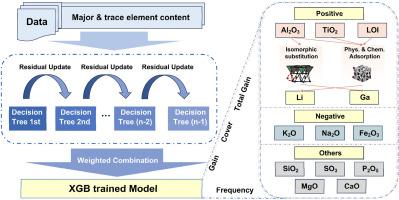Machine learning of lithium and gallium accumulation based on the major element contents in coal gangue from Shanxi province coalfields
IF 3.4
3区 地球科学
Q1 GEOCHEMISTRY & GEOPHYSICS
引用次数: 0
Abstract
Coal gangue, a byproduct of coal mining and processing, contains valuable elements like aluminum, silicon, iron, calcium and titanium, along with a certain amount of lithium (Li) and gallium (Ga). Shanxi, a major coal-producing province in China, produces a substantial amount of coal gangue with Li and Ga accumulation, indicating potential for resource recycling. Nevertheless, the low concentration and dispersed distribution characteristics of Li and Ga in coal gangue pose challenges for their direct determination. This study employed machine learning to assess eight models for analyzing Li and Ga accumulation in coal gangue based on its major components. The results indicated that Li and Ga contents in coal gangue from Shanxi Province coalfields vary widely, with Li and Ga content ranging between 50-300 ppm and 20–40 ppm, respectively. The XGB model showed superior performance in analyzing Li and Ga contents in coal gangue, revealing that Al2O3, TiO2 and loss on ignition (LOI) in coal gangue are positively correlated with Li and Ga contents; while K2O and Na2O are negatively correlated with Li content, and K2O, Na2O and Fe2O3 are negatively correlated with Ga content. The diverse correlations between the major components and the Li and Ga contents in coal gangue may be attributed to the charge imbalance structures of aluminosilicate minerals, isomorphic ion substitution in aluminosilicates, and the physical and chemical adsorption properties of organic matter. This study provides theoretical guidance for exploring the occurrence forms and high-value utilization of trace elements such as Li and Ga in coal gangue.

基于山西煤田煤矸石主元素含量的锂镓富集机器学习
煤矸石是煤炭开采和加工的副产品,含有铝、硅、铁、钙和钛等有价值的元素,以及一定量的锂(Li)和镓(Ga)。山西是中国产煤大省,煤矸石储量丰富,且富集Li和Ga,具有资源循环利用潜力。然而,煤矸石中Li和Ga的低浓度和分散分布特征给直接测定带来了挑战。基于煤矸石主要成分,采用机器学习方法对8种煤矸石中Li和Ga富集模式进行了评估。结果表明,山西煤田煤矸石中Li和Ga含量差异较大,Li和Ga含量分别在50 ~ 300 ppm和20 ~ 40 ppm之间。XGB模型在分析煤矸石中Li和Ga含量方面表现出较好的性能,表明煤矸石中Al2O3、TiO2和燃失量(LOI)与Li和Ga含量呈正相关;K2O、Na2O与Li含量呈负相关,K2O、Na2O、Fe2O3与Ga含量呈负相关。煤矸石中主要组分与Li和Ga含量的不同相关性可能与铝硅酸盐矿物的电荷不平衡结构、铝硅酸盐中的离子同构取代以及有机质的物理化学吸附特性有关。该研究为探索煤矸石中Li、Ga等微量元素赋存形态及高价值利用提供了理论指导。
本文章由计算机程序翻译,如有差异,请以英文原文为准。
求助全文
约1分钟内获得全文
求助全文
来源期刊

Applied Geochemistry
地学-地球化学与地球物理
CiteScore
6.10
自引率
8.80%
发文量
272
审稿时长
65 days
期刊介绍:
Applied Geochemistry is an international journal devoted to publication of original research papers, rapid research communications and selected review papers in geochemistry and urban geochemistry which have some practical application to an aspect of human endeavour, such as the preservation of the environment, health, waste disposal and the search for resources. Papers on applications of inorganic, organic and isotope geochemistry and geochemical processes are therefore welcome provided they meet the main criterion. Spatial and temporal monitoring case studies are only of interest to our international readership if they present new ideas of broad application.
Topics covered include: (1) Environmental geochemistry (including natural and anthropogenic aspects, and protection and remediation strategies); (2) Hydrogeochemistry (surface and groundwater); (3) Medical (urban) geochemistry; (4) The search for energy resources (in particular unconventional oil and gas or emerging metal resources); (5) Energy exploitation (in particular geothermal energy and CCS); (6) Upgrading of energy and mineral resources where there is a direct geochemical application; and (7) Waste disposal, including nuclear waste disposal.
 求助内容:
求助内容: 应助结果提醒方式:
应助结果提醒方式:


